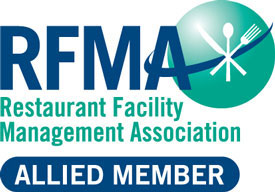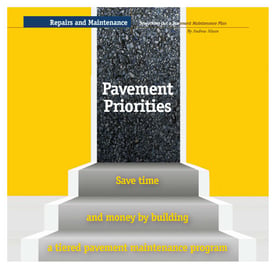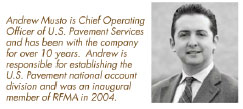Andrew Musto is featured in the April/May edition of RFMA’s “Facilitator” magazine. A full copy of the article can be read below or downloaded here:
Save time and money by building a tiered pavement maintenance program.
 One of the biggest challenges for any restaurant facility manager is balancing the volume of restaurants in your portfolio with the specific need of each location to maintain your brand’s expectations. Every restaurant has different variables and unique challenges, leading to significant complexity when it comes to handling all the trades under your responsibilities.
One of the biggest challenges for any restaurant facility manager is balancing the volume of restaurants in your portfolio with the specific need of each location to maintain your brand’s expectations. Every restaurant has different variables and unique challenges, leading to significant complexity when it comes to handling all the trades under your responsibilities.
How can you prioritize such a long list of restaurants? Which ones have potential liability issues, and which ones need to be kept at an A+ aesthetic to ensure sales goals are hit? How do you build a budget for items that are often unforeseen? With so many restaurants to oversee, it can be difficult to determine which locations need what care.
The benefit of creating a tiered pavement maintenance system is that it replaces the guesswork of allocating resources and funds with real data that helps support a business case regarding which restaurants need attention today, tomorrow and down the road. By assigning a national contractor with pavement expertise to survey your restaurants for you, the resulting data can be a prioritized list, identifying the restaurants with the most urgent repair needs. This will allow for a perspective on your restaurants that incorporates condition, immediate needs and planning for all your locations with an unmatched consistency throughout the country.
The Program
Let me walk you through the steps to build your custom tiered pavement maintenance program:
The first step in establishing the program is evaluating your pavement needs. The results of this survey are normally categorized into three sub-groups: liability repairs, life cycle repairs and overall condition of the store compared to the other restaurants in the inventory.
- Liability repairs: This is the most important of the two types of repairs. This category identifies those locations with pavement surfaces in need of repair/ replacement due to severe cracks, potholes and other trip hazards that can potentially cause injury to clients, guests or employees.
- Life cycle repairs: These are minor repairs that, if not completed in a timely manner, can develop into severe, costly major repairs in the future.
The second step is to identify and prioritize which restaurants need the most maintenance work based on their overall condition. This helps to show which restaurants need maintenance scopes and which can hold off, in many cases saving significant money.
 Using the data in hand, the third step is an objective review of the proposed maintenance pricing versus the budget dollars that are available to help determine the economy of each repair. How can we meet a budget need in terms of total dollars spent or even by average spend per restaurant? Should we only address the busiest locations or the locations with longer lease lives? How can we remove sites that are due for remodel in the next three years? Knowing the repair needs and maintenance recommendations for the entire portfolio allows for this type of detailed analysis, adding in any variables your team requires into the decision-making process.
Using the data in hand, the third step is an objective review of the proposed maintenance pricing versus the budget dollars that are available to help determine the economy of each repair. How can we meet a budget need in terms of total dollars spent or even by average spend per restaurant? Should we only address the busiest locations or the locations with longer lease lives? How can we remove sites that are due for remodel in the next three years? Knowing the repair needs and maintenance recommendations for the entire portfolio allows for this type of detailed analysis, adding in any variables your team requires into the decision-making process.
Another important distinction is based on capitalization options: knowing when to invest in long-term repairs rather than short-term fixes. Looking at all the data from the survey and your available budget, an expert can recommend ways to help ensure capitalization rules are followed and the right overall business decision is made for your budget, your boss and your restaurants.
The Database Method
Experienced national pavement programs incorporate a database into which you can import your stores’ physical asset information, such as square footage of concrete and pavement, number of parking stalls and curbing type. Using this unique parking lot database, a detailed analysis can be performed to determine which restaurants are in the greatest need of maintenance work and which specific repairs are most necessary.
This database method takes pavement maintenance from a yearly event to one that can be planned out multiple years in advance—with little added effort. When this best practice is used consistently from year to year, over time a better understanding of your pavement maintenance needs is established and you can better anticipate and address those repair needs to help ensure all your restaurants look their best. Furthermore, this database provides the foundation for the planned multi-year asphalt maintenance program explained above, which helps you save money and improve the curb appeal of your restaurants to help draw in new business.
Delivering the Work
Of course, once this program is in place and the procurement process has been executed, the real work begins. It should be just as important to the contractor as it is to you that the evaluations and scope of work always have a goal of ensuring the restaurant stays operational throughout any work on-site.
Pavement and concrete work can be scary to on-site restaurant managers. Any contractor must realize that pavement or concrete work can only be delivered successfully if the restaurant’s operations are not affected. The entire team involved—the facility manager, the on-site restaurant manager and especially the contractor—must realize that the customers ultimately pay the bills.
Establishing a pavement maintenance approach that incorporates phasing and delivery work is a critical step to a seamless pavement or concrete project. A tiered pavement maintenance system allows you to let the expert contractor do the work of the evaluation and analysis. This data-driven approach means you can take a step back from the reactive nature of facility management, to a place of making sound business decisions without spending any more time or money. Then, you are truly leveraging vendor relationships to add value for your restaurant organization.
Andrew Musto is Chief Operating Officer of U.S. Pavement Services and has been with the company for over 10 years. Andrew is responsible for establishing the U.S. Pavement national account division and was an inaugural member of RFMA in 2004.











